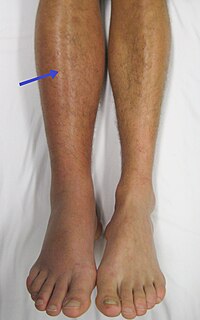
Photo from wikipedia
BACKGROUND Post-thrombotic syndrome (PTS) is a common chronic consequence of deep vein thrombosis that affects the quality of life and is associated with substantial costs. In clinical practice, it is… Click to show full abstract
BACKGROUND Post-thrombotic syndrome (PTS) is a common chronic consequence of deep vein thrombosis that affects the quality of life and is associated with substantial costs. In clinical practice, it is not possible to predict the individual patient risk. We develop and validate a practical two-step prediction tool for PTS in the acute and sub-acute phase of deep vein thrombosis. METHODS Multivariable regression modelling with data from two prospective cohorts in which 479 (derivation) and 1,107 (validation) consecutive patients with objectively confirmed deep vein thrombosis of the leg, from thrombosis outpatient clinic of Maastricht University Medical Centre, the Netherlands (derivation) and Padua University hospital in Italy (validation), were included. PTS was defined as a Villalta score of ≥ 5 at least 6 months after acute thrombosis. RESULTS Variables in the baseline model in the acute phase were: age, body mass index, sex, varicose veins, history of venous thrombosis, smoking status, provoked thrombosis and thrombus location. For the secondary model, the additional variable was residual vein obstruction. Optimism-corrected area under the receiver operating characteristic curves (AUCs) were 0.71 for the baseline model and 0.60 for the secondary model. Calibration plots showed well-calibrated predictions. External validation of the derived clinical risk scores was successful: AUC, 0.66 (95% confidence interval [CI], 0.63-0.70) and 0.64 (95% CI, 0.60-0.69). CONCLUSION Individual risk for PTS in the acute phase of deep vein thrombosis can be predicted based on readily accessible baseline clinical and demographic characteristics. The individual risk in the sub-acute phase can be predicted with limited additional clinical characteristics.
Journal Title: Thrombosis and haemostasis
Year Published: 2018
Link to full text (if available)
Share on Social Media: Sign Up to like & get
recommendations!